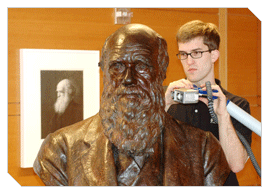|
|
The year 2009 contains two significant anniversaries within the scientific community: the bicentennial of Charles Darwin’s birth and the 150th anniversary of the publication of his groundbreaking book On the Origin of Species. To honor these milestones, the National Academy of Sciences (NAS) commissioned the reproduction of a rare bronze bust of Charles Darwin located in New York City for display at their facility in Washington, D.C. For this challenging task, they contracted John Milner Associates for project management and Direct Dimensions Inc. (DDI) for the technical effort.
The original sculpture was fabricated more than a hundred years ago by the New York Academy of Sciences (NYAS) to mark the 100th and 50th anniversaries of Darwin’s birth and publication of his famous book, respectively. Darwin was then, and probably still is, considered one of their most famous members. Though Darwin had already passed away in 1882, sculptor William Couper used rare photographs to aid in the creation of his very lifelike bronze bust.
…

Add new comment